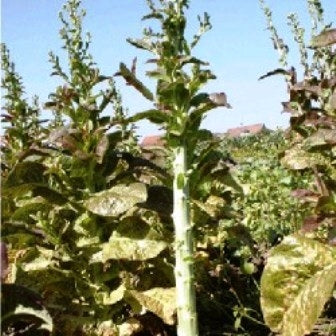ASPARAGUS CRACONVIENSIS - SATIVA vs20
Have a question?

ASPARAGUS CRACONVIENSIS - SATIVA vs20
Dettagli
Scientific name: Asparagus officinalis L.
Family: Liliaceae
Brief history and botanical notes on the plant
Asparagus is a perennial herbaceous plant native to Western Asia, already known at the time of the Egyptians, who spread its cultivation throughout the Mediterranean basin; it subsequently spread overseas too.
The world's largest producers are China, Peru, Mexico and the United States, while in Europe Italy provides the highest yields, mainly in Veneto, Emilia Romagna and Piedmont.
Garden asparagus belongs to the Liliaceae family, genus Asparagus, and includes over two hundred species.
The plant consists of a weak stem, small leaves and flowers, the fruits are red berries the size of a pea; the root system is very developed. The edible part is represented by the shoots, tender elongated shoots that develop from the buds of the stem.
Asparagus is a dioecious plant, the male plant is more vigorous and productive, but produces thinner and less profitable shoots. 
Pedoclimatic needs
Asparagus, as demonstrated by its diffusion, is a very adaptable plant from a climatic point of view; However, it fears the return of cold weather which delays the growth of shoots and compromises their quality.
The plant prefers light, loose and sandy, slightly alkaline soils; it does not adapt to sub-acid soils which therefore require corrections.
Sowing and transplanting times
The asparagus plant is carried out using one/two year old legs or potted plants; the latter technique has become increasingly widespread in recent years because it guarantees a higher percentage of rooting.
Asparagus cultivation remains in the ground for approximately 12/15 years, therefore it cannot be included in normal agricultural rotations; the cultivation of the soil is quite deep (about 60 cm). The planting spacing is 100 cm between the rows and 30 cm on the row, with a total investment of 30,000 seedlings per ha; it is better to opt for transplanting in a single row, which facilitates frequent subsequent processing.
Processing
Asparagus cannot tolerate water stagnation, therefore the processes that favor the aeration of the soil are important: weeding which is carried out by hand on the row and mechanical harrowing and milling between the rows. Processing must be frequent to control the presence of weeds that depress the plants, causing a reduction in the quality and quantity of shoots; let's not forget that at various times of the year cultivation is not competitive with weeds.
If you want to produce white asparagus, the rows are earthed up to encourage whitening.
At the end of each season the aboveground part must be cut close to the ground and removed from the field; this is to avoid the proliferation of fungal diseases and parasite attacks.
Fertilizations
It is a very demanding plant and requires an abundant supply of manure to the plant; manure or compost must then be used regularly during the winter rest phase, burying them with light milling. The use of manure is also useful.
Crop care and irrigation
Tunneling is commonly used to improve shoot quality and avoid damage from late frosts. The covers are placed before the release of the shoots and maintained for a month after the end of the harvest.
The plant also suffers from stagnation and water stress: it therefore requires constant frequency of irrigation. During the harvesting phase it is necessary to keep the soil constantly moist, to obtain the maximum productive and qualitative expression of the shoots.
Adversity
Good cultivation practices such as rotation, the use of mature compost, correct and timely under-foliage irrigation, ensure the success of the crop.
Rust and stemphilosis are the most dangerous fungal pathologies, capable of causing serious damage; the damage caused by insects is more limited, mainly aphids and the asparagus fly (which causes the deformation of the shoots).
Defense products
No particular problems are encountered in biodynamic gardens, therefore we recommend correct use of biodynamic preparations also as prevention.
In case of major rust attacks, use copper or propolis.
Production and collection
The harvest is gradual and is carried out with a special gouge knife, when the shoot is 12 cm long. in the cultivation of green asparagus. In case of bleaching with earthing up the soil, it is collected
as soon as the shoot emerges from the trunk.
The harvest lasts for approximately 60 days, with very variable yields depending on the area and cultivation conditions, approximately 50/100 q/ha.
Nutritional values
100g of asparagus (41 Kcal) contains: 87.5 g of water, 5.1 g of proteins, 0.3 g of fat, 4.7 g of carbohydrates.
They are rich in vitamins of groups A, B and C, calcium, potassium and phosphorus; they contain abundant fiber and provide a modest caloric content.
They have good diuretic and laxative properties, therefore it is useful to consume them in case of constipation, water retention and cellulite.
Family and variety
Asparagus belongs to the Liliaceae family, among the most cultivated varieties we remember the Violetto di Albenga and the Precoce di Argenteuil.
Biodynamics
On days of soil and water, distribute the preparation 500 before transplanting and weeding.
To improve the quality of the shoots, distribute the 501 preparation on the summer vegetation, on days of air or fire, on sunny days.
Use of the biodynamic calendar: transplanting and weeding must be carried out on the descending moon, on earth days.


